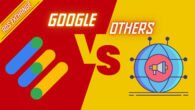
The Evolution of AdTech: Google’s Exchange Network Perspective
The digital world is constantly evolving, and with it, the ways in which we advertise have transformed dramatically. At the heart of this change is AdTech, a term that might sound technical but is crucial in shaping the ads we see online. One of the major players in this field is Google, whose Exchange Network has revolutionized digital advertising. But how did we get here? What changes have taken place, and what does this mean for the future of advertising? Let’s dive into the fascinating evolution of AdTech from Google’s Exchange Network perspective.
The Role of Google AdX in Digital Advertising
Understanding AdTech
AdTech, short for advertising technology, encompasses all the software and tools used by advertisers, agencies, publishers, and other players in the digital advertising ecosystem to target, deliver, and analyze their digital advertising efforts. It’s a broad field that includes data management platforms (DMPs), demand-side platforms (DSPs), supply-side platforms (SSPs), and more.
The Birth of Online Advertising
Online advertising began in the mid-1990s when the internet was becoming a household name. Banner ads were the first form of online ads, simple static images placed on websites. They were a far cry from the sophisticated, targeted ads we see today, but they laid the foundation for what was to come.
Google Enters the Ad Scene
In 2000, Google launched AdWords, now known as Google Ads. This was a game-changer. Instead of relying on banner ads, Google Ads introduced pay-per-click (PPC) advertising. Advertisers could bid on keywords, and their ads would appear in search results when those keywords were used. This marked the beginning of more targeted and effective online advertising.
Here’s a look at the key aspects and impacts of Google’s foray into the ad world:
Timeline and Key Developments
- AdWords Launch (2000):
- Google introduced AdWords, an online advertising platform that allowed businesses to display ads on Google’s search engine. It used a pay-per-click (PPC) model, charging advertisers only when users clicked on their ads.
- Initially, ads were served on a CPM (cost per thousand impressions) basis, but this later evolved to the PPC model we are familiar with today.
- AdSense Introduction (2003):
- Google launched AdSense, enabling website publishers to earn revenue by displaying Google ads on their websites. This expanded the reach of Google’s ad network beyond its own properties.
- Acquisition of DoubleClick (2007):
- Google acquired DoubleClick, a company specializing in display ad technology and serving. This move significantly bolstered Google’s display advertising capabilities, allowing it to serve more sophisticated and targeted ads across the web.
- Development of Google Display Network (GDN):
- Google created the Google Display Network, encompassing millions of websites, videos, and apps where ads can be displayed. This network allowed advertisers to reach a broad audience across diverse content.
- Introduction of Programmatic Advertising:
- With advancements in machine learning and data analytics, Google began offering programmatic advertising solutions, automating the buying and placement of ads based on real-time data and user behavior.
Key Features and Innovations
- Keyword Targeting:
- AdWords pioneered keyword-based advertising, allowing ads to be shown based on the search queries entered by users. This significantly increased ad relevance and effectiveness.
- Quality Score:
- Google introduced the Quality Score metric, which considers the relevance and quality of the ad and the landing page. This innovation encouraged advertisers to create better user experiences.
- Remarketing:
- Google developed remarketing techniques, enabling advertisers to target users who had previously visited their websites, thereby increasing the chances of conversion.
- Ad Formats and Extensions:
- Over the years, Google expanded its ad offerings to include various formats like text, display, video, and shopping ads, along with ad extensions that provide additional information like location, phone numbers, and site links.
Impact on the Advertising Industry
- Data-Driven Advertising:
- Google’s approach to leveraging user data for ad targeting set new standards for data-driven advertising. This led to more personalized and effective ad campaigns.
- Accessibility for Small Businesses:
- By offering self-serve ad platforms with flexible budgets, Google democratized advertising, making it accessible to small and medium-sized businesses.
- Shift to Online Advertising:
- Google’s success with AdWords and AdSense demonstrated the effectiveness of online advertising, prompting a significant shift of advertising budgets from traditional media to digital platforms.
- Industry Standards:
- Innovations like PPC pricing, keyword targeting, and programmatic buying established new industry standards that were adopted by other digital advertising platforms.
- Revenue Generation:
- Google’s advertising business became its primary revenue stream, funding the development of other services and technologies. As of recent reports, a substantial portion of Google’s revenue still comes from advertising.
Challenges and Controversies
- Privacy Concerns:
- Google’s data collection practices for ad targeting have raised privacy concerns and regulatory scrutiny, leading to changes in policies and increased focus on user data protection.
- Ad Fraud and Quality Issues:
- The digital ad industry faces challenges like ad fraud, where fake clicks and impressions generate false ad performance metrics. Google has implemented measures to combat this but it remains an ongoing issue.
- Market Dominance:
- Google’s dominance in the digital ad market has sparked antitrust investigations and calls for regulatory measures to ensure fair competition.
Google’s entry into the ad scene marked a pivotal moment in advertising history, transforming how businesses reach their audiences and shaping the future of digital marketing.
The Rise of Ad Exchanges
As online advertising grew, so did the need for more efficient ways to buy and sell ad space. This led to the creation of ad exchanges. An ad exchange is a digital marketplace where advertisers and publishers can buy and sell ad space in real-time through automated auctions. This was a major advancement, making the process faster and more efficient.
What is Google’s Exchange Network?
Google’s Exchange Network, also known as Google Ad Exchange or AdX, is one of the largest and most influential ad exchanges in the world. It allows advertisers to bid on ad space across a vast network of websites and apps, reaching millions of users. AdX operates on a real-time bidding (RTB) system, where ad impressions are bought and sold in milliseconds.
How Google’s Exchange Network Works
The process begins when a user visits a website that has ad space available. The website sends a request to the ad exchange, which then conducts an auction among advertisers who are interested in displaying their ads to that user. The highest bidder wins, and their ad is shown on the website almost instantly. This all happens in the blink of an eye, making the advertising process incredibly efficient.
Unlocking Success: Innovative Strategies with Google’s Exchange Network
The Impact on Advertisers
For advertisers, Google’s Exchange Network offers several benefits. First, it provides access to a vast audience, increasing the chances of reaching potential customers. Second, the real-time bidding system ensures that advertisers only pay for impressions that are likely to be valuable. This targeted approach makes advertising more cost-effective and efficient.
The Impact on Publishers
Publishers also benefit from Google’s Exchange Network. They can monetize their content more effectively by auctioning off their ad space to the highest bidder. This can result in higher revenue compared to traditional ad sales methods. Additionally, the automated process reduces the administrative burden on publishers, allowing them to focus on creating quality content.
User Experience and Privacy Concerns
While Google’s Exchange Network has many advantages, it also raises concerns about user experience and privacy. Some users find targeted ads intrusive, and there are growing concerns about how user data is collected and used. Google has implemented several measures to address these issues, such as providing users with more control over their ad settings and ensuring compliance with privacy regulations like the GDPR.
Innovations and Future Trends
AdTech is a rapidly evolving field, and Google’s Exchange Network is continuously innovating to stay ahead. One significant trend is the increasing use of artificial intelligence (AI) and machine learning to optimize ad targeting and delivery. These technologies can analyze vast amounts of data to predict which ads are likely to be most effective, improving the efficiency of the ad exchange.
Challenges in AdTech
Despite the advancements, the AdTech industry faces several challenges. Ad fraud is a major issue, with billions of dollars lost each year to fraudulent activities. Ensuring transparency and trust in the ad exchange process is another critical challenge. Moreover, balancing effective ad targeting with user privacy remains a delicate task.
Google’s Response to AdTech Challenges
Google has been proactive in addressing these challenges. It has implemented strict measures to combat ad fraud, such as using AI to detect and block fraudulent activities. Google also prioritizes transparency, providing detailed reports to advertisers and publishers about ad performance. On the privacy front, Google continues to enhance its tools to give users more control over their data and comply with global regulations.
The Future of AdTech
Looking ahead, the future of AdTech, especially from Google’s perspective, is promising. We can expect continued advancements in AI and machine learning, making ad targeting even more precise and efficient. Privacy will remain a top priority, with ongoing efforts to develop new technologies that protect user data while enabling effective advertising. The integration of new formats, such as interactive and immersive ads, is also likely to shape the future landscape of digital advertising.
Conclusion
The evolution of AdTech, particularly through Google’s Exchange Network, has transformed the digital advertising landscape. From the humble beginnings of banner ads to the sophisticated, real-time bidding systems of today, the journey has been remarkable. Google’s Exchange Network has played a pivotal role in this evolution, offering immense benefits to advertisers and publishers while continuously innovating to meet new challenges. As we look to the future, the possibilities are endless, promising a dynamic and exciting era for digital advertising.
FAQs
1. What is AdTech?
AdTech, short for advertising technology, refers to the tools and software used to deliver, target, and analyze digital advertising.
2. How does Google’s Exchange Network work?
Google’s Exchange Network operates on a real-time bidding system, where advertisers bid on ad space in real-time auctions, and the highest bidder’s ad is displayed to the user.
3. What are the benefits of using Google’s Exchange Network for advertisers?
Advertisers benefit from access to a vast audience, cost-effective ad targeting, and increased efficiency through automated processes.
4. How does Google address privacy concerns in its Exchange Network?
Google provides users with more control over their ad settings and ensures compliance with privacy regulations like GDPR to address privacy concerns.
5. What are the future trends in AdTech?
Future trends in AdTech include advancements in AI and machine learning, new ad formats like interactive ads, and ongoing efforts to enhance user privacy.








Leave a Reply